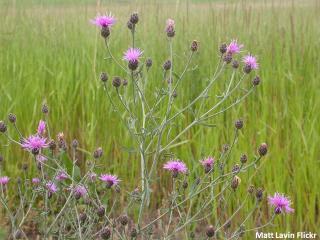Why Should You Care About Noxious Weeds?

Noxious weeds are non-native, invasive plants that outcompete native grasses and wildflowers and can seriously impair wildlife habitat, agriculture, and recreational opportunities. Millions of acres of rangeland, forest, wetland and cropland are infested with noxious weeds in Montana. There are 36 species of invasive plants listed as noxious weeds in the state, and an additional four species listed in Gallatin County.
When you work to manage noxious weeds you are helping to protect:
- Native plant communities – Native plants are replaced by noxious weeds, resulting in a loss of plant diversity and the simplification of plant communities.
- Local agriculture – Loss of forage and livestock production, declines in crop yields, and the time and money spent managing noxious weeds cost Montana farmers and ranchers millions of dollars every year.
- Wildlife habitat -- Noxious weeds replace beneficial plants that provide food and shelter to all wildlife, from songbirds to elk. Consequently, noxious weeds reduce the amount and quality of habitat for wildlife and may contribute to long-term population declines.
- Good relations with your neighbors – Noxious weeds are frequently a source of disputes among neighbors because weeds can quickly spread from one property to another. Don’t be the seed source for your neighborhood!
- Property values – Noxious weed infestations often require a lot of time and money to get under control. Noxious weeds degrade the quality of pastureland and reduce available forage for livestock.

